September 2002
Ciad Mile Failte
New Brunswick & Nova Scotia




September 2002
Ciad Mile Failte
New Brunswick & Nova Scotia
Or Bien Bienvenue!
We’ve spent the last five weeks or so in Canada, mostly in beautiful, fantastic Nova Scotia. Ciad Mile Failte is gaelic for a hundred thousand welcomes; bienvenue is French for a smiling open-hearted welcome as well. And have we ever felt at home and among friends here. The countryside is lovely, but it’s the charming mixture of cultures that has us caught in Nova Scotia’s web.
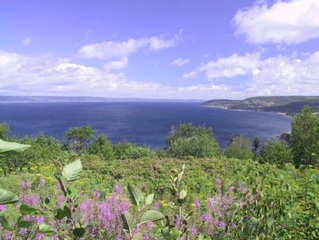
August is a grand time to be up here. The wild raspberries, blueberries and blackberries are coming on, providing an accompaniment to many dishes of fresh fruit. The weather has been lovely, in the high 80’s (that’s 32 degrees Celsius to the locals), which is warm inland but splendid with the cool ocean breezes. The views are so spectacular along the Cabot Trail. The Cabot Trail is highly touted as one of the loveliest drives anywhere, a reputation it greatly deserves. The Trail circumnavigates most of the north end of the island, and presents rocky coasts and picturesque harbors aplenty. For motorcyclists, it’s one of “the” rides in North America. But it’s also narrow and windy and scary. The recommendation is to “do the Trail” clockwise, because you get to hug the hillside instead of having your rump hanging out over the edge looking down – a long ways down. But then you only get to see half the special views; so we’ve gone back and forth both ways several times, not missing anything, and taking pictures wherever we can. And what pictures we have! Wow! Rick has added some new equipment to the digital camera, giving him extra zing to his shots.
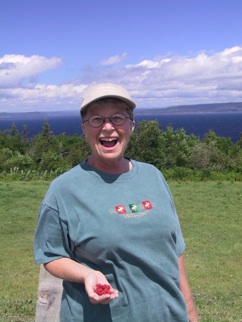
We’ve noticed the generally poor roads throughout Canada, but it has also been true over many parts of the United States. We continue to feel that New York has the best roads we’ve seen anywhere. Go you New Yorkers! Elsewhere the roads are very spotty. And you already know California has realllllllly lousy roads. So no local bragging rights out West!
Our campgrounds are filled with Canadians, naturally, many of them from Quebec. We hear as much French as English spoken around us; a tiny little cherub just marched by singing “Frere Jacques”; a treat to be remembered. Everyone in a campground is an instant friend, regardless of the language spoken, because of the shared experiences. They stop by to admire our motorcycle, or the coach, and we are enjoying the many versions of tent trailers and tents and small motorhomes. Often, we are the biggest beast around, which has surprised us. We do continue to see large motor coaches, of course, but they are more likely to be American than Canadian. We’re very glad we aren’t any larger than we are; these little villages are just that. The big coaches must be parking on the edge somewhere and walking in, that’s all I can figure. They can be as overwhelming as tour busses.
The gaelic presence in Cape Breton is personified by the St. Anns Gaelic College of Celtic Arts and Crafts, the only gaelic college in North America. Stopping by is a treat all by itself, but concerts and events are held there regularly. We spent time in the Hall of the Clans, which illustrates Scottish history, both in Scotland and locally. The various clans are represented by their histories and their tartans, and the gift shop is full of splendid woolens and cloth to purchase, along with many other irresistible items (any one for a gaelic dictionary?) Not meaning to make light of the place, it’s a fascinating stop. We attended two events, the first a Mhoid, a Gaelic Mod, which included workshops on speaking gaelic (which we skipped), a codfish supper (give a guess – Rick eating codfish? Hah!), a milling frolic (you have to come and find out for yourself what that is), and a Ceilidh to top it off. A ceilidh is a concert, and this was great fun. It was put on by students at the college, joined by many locals, including a bagpiper and a couple of brothers in their 70’s. Lots of singing and fiddling; very low key and informal, which suited the occasion. We then went back a week later for a Fiddlers Festival. Interestingly, it had all these same other kinds of folks too, in addition to the fiddlers. Again, more low key than we are used to. We had a good time at both events. At the fiddling event it was Mary Margaret MacGillvray’s 101st birthday; the crowd stood and sung to her. What fun!
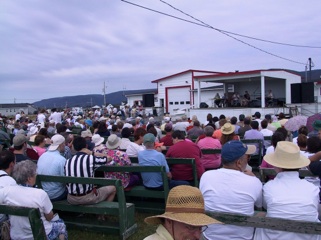
A treat for both of us has been to sit and watch the local people out enjoying themselves, and to see our own ancestors reflected in their faces. We both have plenty of Scottish-Irish-English blood in us and keep seeing family members sitting next to us.
What is quite apparent in these concerts is that they aren’t really “performances” such as we’re used to. The participants range from the quite elderly to the very young. Cape Breton Island is chock full of ancient traditions, and there is a strong desire to make sure these traditions are passed on to each succeeding generation. So when someone is on stage, they aren’t performing, they’re sharing what they know. These songs and dances and tunes are played at home all the time to make sure they are passed along. So when someone finishes, they aren’t so concerned that they’ve “performed well;” they hope you enjoy what they have to offer. The step dancers have something they do which is great fun; they dance while accompanied by a fiddle and maybe a piano. But they make all the decisions. Quite obviously, they dance until they cannot dance any longer; then they simply stop, turn around, and leave the stage. The others are left trying to make the music stop in a way that might make some sense!
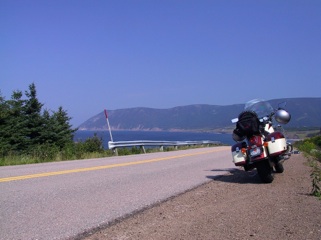
The food has been great, and surprisingly inexpensive. We stopped at a “Celtic Tea Room” for lunch one day. It was in one of the small churches that are everywhere on the island. I had a lobster sandwich (it was good, but not really special: chunks of lobster with some mayonnaise on the bread); Rick saw they were still serving breakfast, and had the local version of French toast, which he pronounced quite good. We also had the best fish and chips either of us has had in quite awhile, at another stop. The fish is very fresh, of course, and yummy.
We have enjoyed several national parks in Canada, as well as many, many historic sites. Canada does a good job with its historical “opportunities.” One very interesting spot was Baddeck (pronounced Ba-DECK), where Alexander Graham Bell spent many years post-telephone invention. The phone is all we ever remember him for, but he was a prolific inventor, and also instrumental in developing ways to teach the deaf. The museum was a beautiful building with extremely interesting exhibits. And Baddeck is gorgeous, right on the water (as are some many of the lovely villages on the island). And by the way, if you are looking for a B&B recommendation on Cape Breton Island, I’d start with Castle Rock Country Inn in Ingonish. It’s perched on the edge of a cliff with a splendid view; no idea if the accommodations are any good, but who cares with that view?
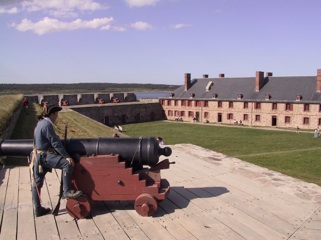
As you probably know, there’s much more to Nova Scotia than just Cape Breton Island. The two sections are connected by the Canso Causeway, and there’s plenty of countryside “below.” Halifax is the capital, and it’s an interesting place. It’s defined by a very large, very deep, very important harbor. Halifax goes waaay back in history, mostly through its connection to the sea. We enjoyed several days in the area, checking out an excellent maritime museum (for non-boating people, we really are very interested in maritime stuff: suppose we had fish for ancestors??), and wandering around this really cool citadel that was built early in the 19th century and which came complete with bagpipers and marching soldiers in appropriate uniforms. Great fun. One of the nicest things about being there was that we had made contact with and were traveling with our good friends Pat and Kasey Johnston, formerly of Los Osos and now living in Lake Tahoe. It was good to see them. They ARE boating people, and gave us new perspectives on what we were seeing. We have since parted, and miss them. They lucky ducks, they are still on Cape Breton Island as of this writing.
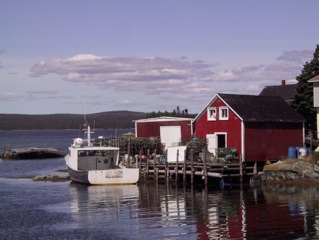
When we think of Nova Scotia, harbors and forest and little white churches come to mind, with water everywhere. They grow corn, apples, and hay, and have lots of dairy farms. Add in the delightful and friendly inhabitants, and what more could you want?
Even though the majority of our time in the Maritime Provinces was spent in Nova Scotia, we also enjoyed New Brunswick very much. We had a delightful night camping at tiny Dipper Harbor and eating the best salmon I’ve ever had, at the Fundy Haven Restaurant. As you cross into Canada from Maine, St. John is the first major town, and we spent several days camping in the park there, a lovely spot. The New Brunswick Museum is there, and it has a fascinating exhibit on ship construction during the “old days” that was well worth the price of admission. The Bay of Fundy is a huge tourist attraction. This bay has a natural phenomenon of very high tides (the highest in the world). Boats are left hanging at low tide; when at its highest huge areas are underwater. We were particularly fascinated by the huge mud flats that are every where at low tide and disappear rapidly as the tide comes in. The whole Bay of Fundy area is affected by these tides and they are a major tourist attraction. There are many charming small towns, each with at least one very picturesque church. They are Anglican and United Church of Canada mostly, with others mixed in. Each and every one worthy of a picture or two.
To go between New Brunswick and Nova Scotia you have to cross the Bay of Fundy at Moncton; it has two bridges, one is very very very narrrrrrow and is marked as a no-no for RVs; unfortunately with very small signs that can’t be seen until it is too late. We took a wrong turn and ended up crossing this puppy; very slowly, stopping traffic, people cursing; all the things you’d expect. Rick is a master at this by now, and we only dinged the right hand mirror twice, and that only because a couple of the bridge struts were bent. Never again!
Every sign in New Brunswick is in both English and French. This disappears when you get to Nova Scotia. It seems as though once you get one province removed from Quebec, their influence lessens. All the national signs were in both languages, of course, but not regular road signs, or names on buildings.
After a grand and lovely visit, we crossed back into the United States at the little town of St-Leonard. It is quite far north in New Brunswick, and the entire area, both in Canada and the US, shows strong French influences. Most of the people are bilingual, I read, and the towns and buildings reflect that heritage. In many ways we were very frumpy about leaving the Maritime Provinces. However, there are some things we have missed: lifesavers, enchilada sauce, decent crackers for three examples. Also, our phone now can be used without costing a fortune and our mail takes less than two weeks to find us (really!).
A comparison of costs? Fuel is more expensive in Canada, but food is cheaper, both in the stores and eating out. Campgrounds are considerably less expensive, although they often have no hookups. All told, is it a “good deal” traveling in Canada? You bet! We’ll be back next year, as we’ve said, and will stay much longer. We want to go to Newfoundland and Prince Edward Island, and we’ve only seen about half of Nova Scotia and New Brunswick. To say nothing of Quebec. So we expect to spend 4-5 months there next year.
For now, though, it’s a little like coming back from the far side of the moon, and we’re happy enough being here. On to the Fall Color in New England!
Rick and Kathy
See more photos from 2002-2003

